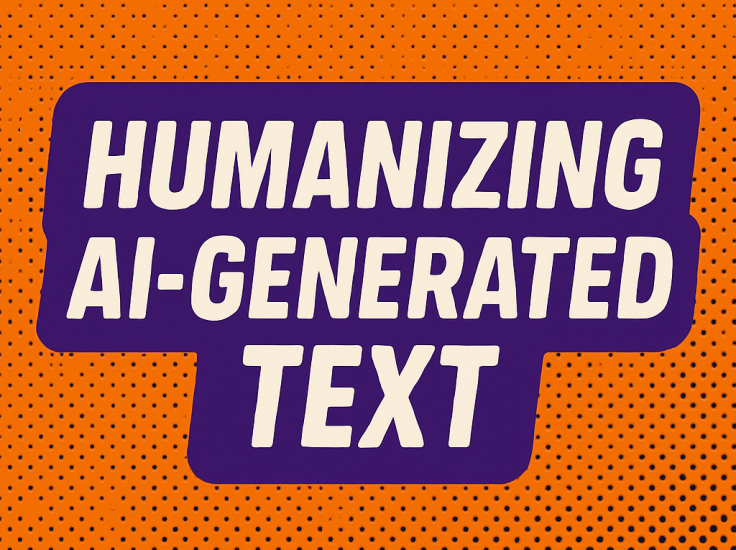Humanizing AI Generated Text
1 student
Last updated 10/2025
Overview
Curriculum
Instructor
Understand the process of humanizing AI-generated text with comprehensive techniques for making AI writing indistinguishable from human-authored content. Learn how AI detection tools work, discover linguistic and stylistic strategies to add human voice and variability, and explore formatting techniques that eliminate AI markers. Perfect for students, academics, and professionals who use AI writing assistance but need their content to maintain authenticity and avoid false positives from detection tools.
Course Features
- Lectures 7
- Quizzes 0
- Duration 50 hours
- Skill level All levels
- Language English
- Students 1
- Certificate Yes
- Assessments Yes
Curriculum
- 7 Sections
- 7 Lessons
- Lifetime
Expand all sectionsCollapse all sections
- Module 1This opening module defines what it means to "humanize" AI-written text and why it matters. We discuss the reasons one might want AI-generated content to appear more human – from improving readability and trust to avoiding false positives from AI detection tools. Learning Objectives: Define "humanizing" AI text and understand its importance Recognize scenarios where humanization is beneficial Understand the course scope and free techniques focus Appreciate the importance of ethical AI use1
- Module 2In this module, we delve into the mechanisms behind AI detection tools. Understanding what features make text seem "AI-written" will help you know what to change or avoid. Learning Objectives: Learn how AI content detectors analyze text Understand perplexity and burstiness concepts Recognize common AI text markers that detectors flag Understand how and why false positives occur Appreciate the limitations of current AI detectors1
- Module 3This module covers language-level and sentence-level techniques for making AI-generated text sound more human. We focus on the words and sentence structures: how to rephrase sentences, use diverse vocabulary, and introduce variability that AI outputs often lack. Learning Objectives: Identify AI-sounding language patterns and markers Vary vocabulary using synonyms and natural word choices Diversify sentence structure for greater variety (burstiness) Incorporate natural phrasing and human-like touches Balance humanization without losing clarity or meaning1
- Module 4This module explores techniques at the broader stylistic level – tone, voice, and formatting choices – that can make AI-generated text feel even more human. While Module 3 dealt with sentence-level edits, here we consider the overall style of a piece and document-level clues. Learning Objectives: Adjust tone and voice to match human writing styles Add personal anecdotes, opinions, and analogies for authenticity Structure content in non-formulaic ways Remove AI formatting quirks and technical markers Finalize a polished, human-like document1
- Module 5This module is a practical workshop. We will take a sample AI-generated passage and walk through the process of humanizing it using the strategies from Modules 3 and 4. This "before-and-after" case study will help reinforce how each change contributes to making the text sound more human. Learning Objectives: Identify issues in AI-generated text within context Apply step-by-step humanization process Compare before vs after results and understand improvements Practice self-editing techniques on your own content Integrate all learned skills into cohesive editing workflow1
- Module 6This module introduces The Prompt Index AI Humanizer tool, which can assist in humanizing AI-generated text. We'll cover the capabilities of this tool, including its free features and premium options, and how to integrate it into your writing workflow. Learning Objectives: Understand The Prompt Index AI Humanizer capabilities and use cases Learn free vs premium features and their applications Understand how the tool detects and transforms AI patterns Master step-by-step tool usage for effective results Integrate the tool into your writing and editing workflow1
- Module 7In this final module, we will conclude the course with a summary of the key lessons learned about humanizing AI-generated text. We'll reinforce the importance of combining these techniques with ethical writing practices and provide suggestions for continued improvement. Learning Objectives: Summarize key humanization techniques and strategies Build confidence in applying learned skills to real work Understand ethical considerations and responsible use Plan for lifelong learning and skill development Identify next steps and practice opportunities1
Stephen is an AI fanatic, entrepreneur, and educator, with a diverse background spanning recruitment, financial services, data analysis, and holistic digital marketing. His fervent interest in artificial intelligence fuels his ability to transform complex data into actionable insights, positioning him at the forefront of AI-driven innovation.
Stephen’s recent journey has been marked by a relentless pursuit of knowledge in the ever-evolving field of AI. This dedication allows him to stay ahead of industry trends and technological advancements, creating a unique blend of analytical acumen and innovative thinking which is embedded within all of his meticulously designed AI courses.
He is the creator of The Prompt Index and a highly successful newsletter with a 10,000-strong subscriber base, including staff from major tech firms like Google and Facebook. Stephen’s contributions continue to make a significant impact on the AI community.
Courses You May Like.





